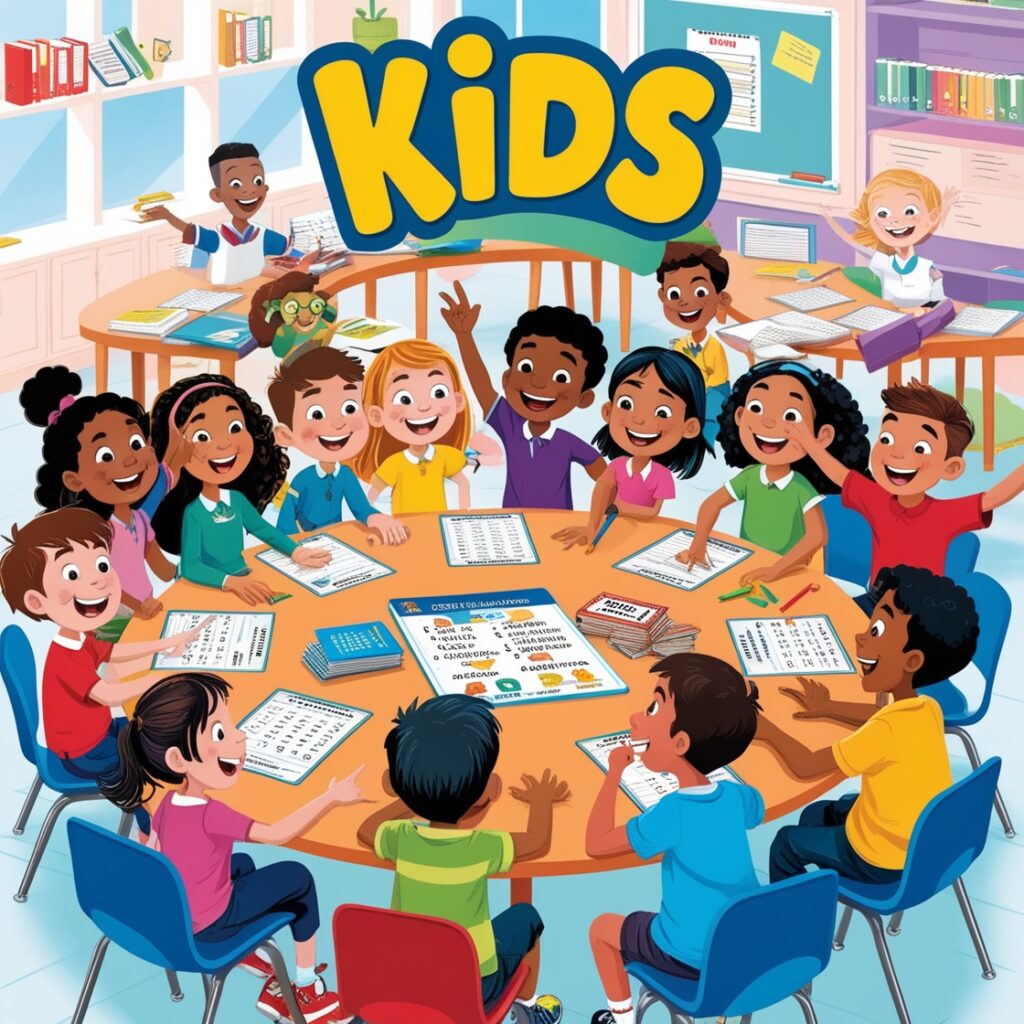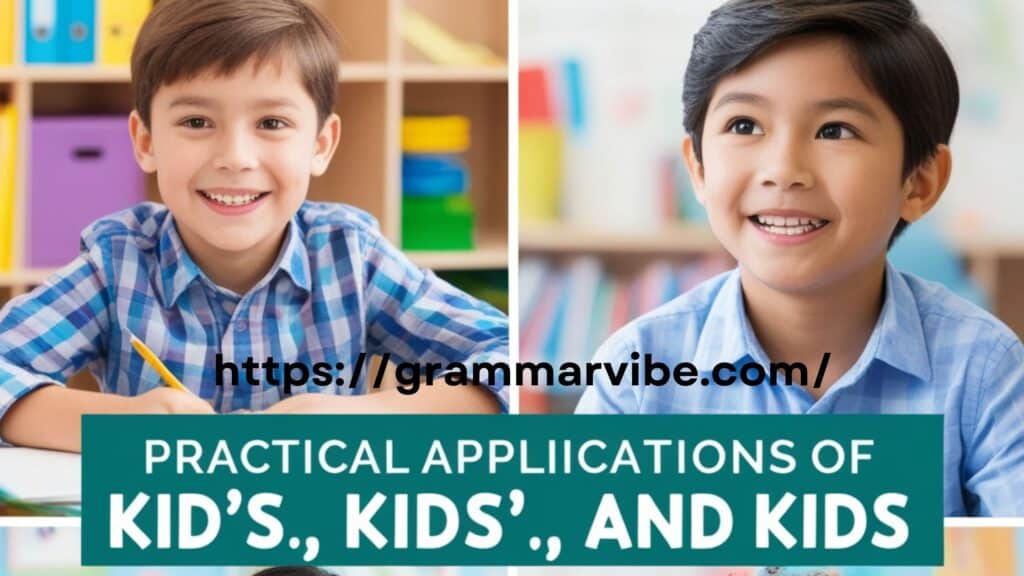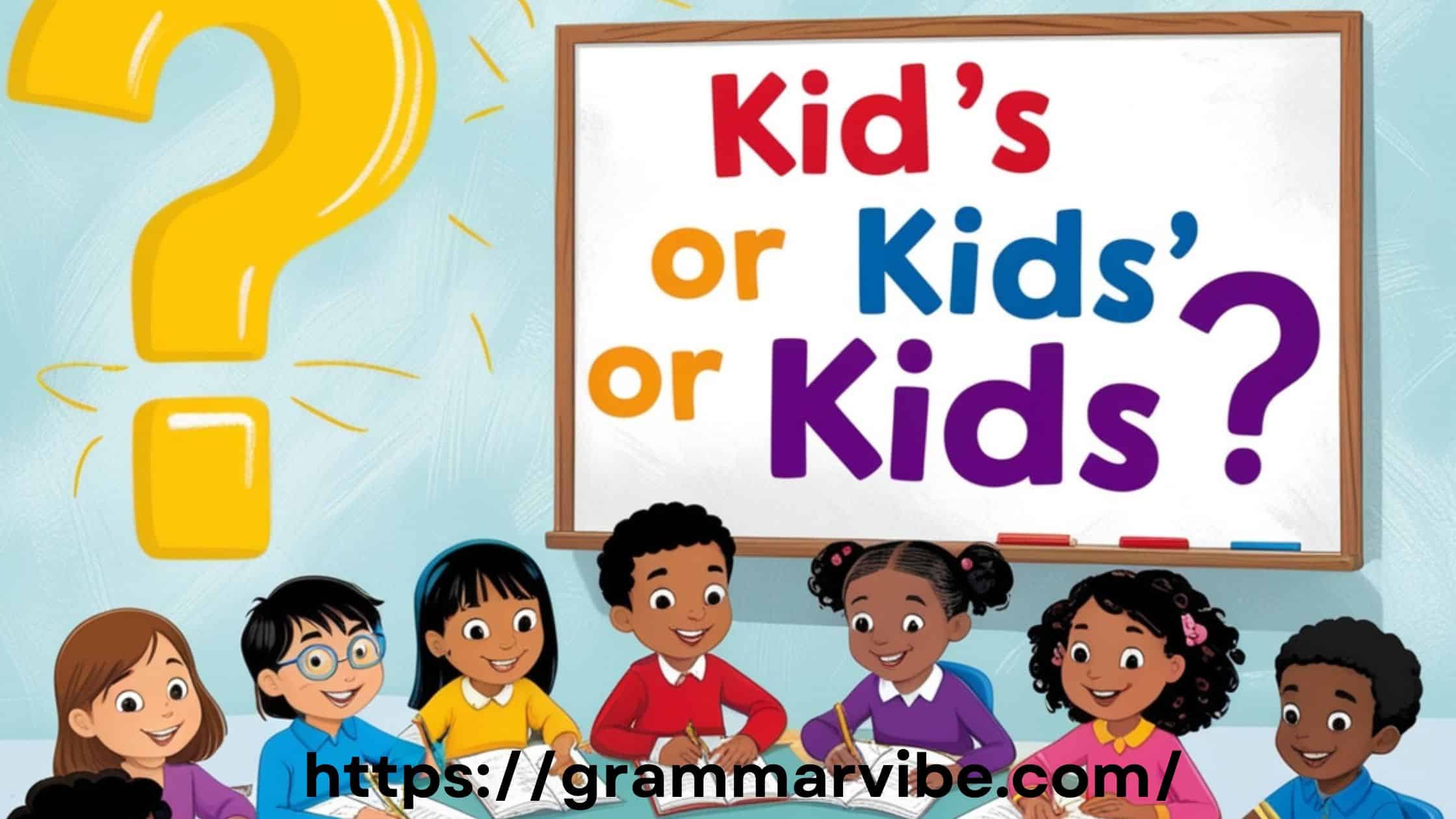When using the word “kid” in different forms, grammar can get tricky. Understanding how to express possession—whether you’re talking about a single child or a group of children—is essential for clear, effective communication.
This guide will walk you through the singular possessive form (kid’s), the plural possessive form (kids’), and the standard plural (kids). We’ll break down examples, scenarios, and grammar rules to ensure you’re confident in using each form.
The Basics: Kid’s, Kids’, and Kids
Before we dive into possessive forms, let’s clarify the three variations:
- Kid’s: Singular possessive, referring to something that belongs to one kid.
- Kids’: Plural possessive, indicating something that belongs to multiple kids.
- Kids: Standard plural, used when talking about more than one kid in a general sense, without possession.
Each form has unique uses, and getting them right is essential for clear writing. Let’s look at each in detail, with examples and scenarios.
Kid’s (Singular Possessive)
When we use kid’s, we’re talking about something that belongs to one kid. This form is made by adding an apostrophe and an “s” to the singular form of the word “kid.”
Usage and Examples of Kid’s in Sentences
The singular possessive example is helpful when you’re referring to an item, quality, or action associated with one child. For instance:
- The kid’s toy was lying on the floor.
- The kid’s smile lit up the entire room.
In both cases, we’re referring to one child, and the apostrophe + “s” shows that the item or action belongs to them.
Scenario Examples
- Family Gathering: “Could you please pick up the kid’s toy from the living room? It’s been there since the morning.” Here, kid’s indicates that one specific child owns the toy.
- School Note: “The teacher praised the kid’s artwork and put it on display.” This shows that one child created the artwork, and it belongs to them.
The singular possessive form is useful for identifying individual ownership and is often applied to physical parts of a kid or belongings like toys or school supplies.
You might also like: Other Ways to Say “With That Being Said”
Kids’ (Plural Possessive)
The kids’ form is the plural possessive. This form is used to show ownership by more than one child, and you create it by adding an apostrophe after the plural form, “kids.”
Usage and Examples of Kids’ in Sentences
When discussing items, spaces, or actions involving multiple kids, kids’ is appropriate. Examples include:
- The kids’ playground was busy with laughter and games.
- The kids’ schedules were packed with activities all week.
In these sentences, the plural possessive example shows that something belongs to a group of children, whether it’s a playground designed for kids or schedules full of activities.
Scenario Examples
- Community Center: “The new kids’ playground has slides, swings, and a climbing wall.” Here, we’re talking about a playground that is designated for all children, not just one.
- Summer Camp: “The counselor organized the kids’ schedules to include swimming, crafts, and sports each day.” In this case, the schedule applies to multiple children, not just one.
The plural possessive kids’ is perfect for talking about belongings of kids or spaces for kids shared by a group.
More for you: Boy Possessive Forms: Boy’s or Boys’ or Boys
Kids (Standard Plural)

The word kids is the standard plural of “kid.” It doesn’t indicate possession, so it’s simply used when you’re referring to more than one child without assigning ownership.
Usage and Examples of Kids in Sentences
Examples of kids in general include:
- The kids gathered around the storyteller to hear the tale.
- The kids were excited to start the field trip.
This version is straightforward and works when discussing children in groups without pointing to specific ownership.
Scenario Examples
- Park Outing: “The kids enjoyed playing on the swings and slides.” Here, “kids” refers to a group of children at play, with no possessive meaning.
- School Performance: “All the kids sang beautifully during the recital.” In this sentence, “kids” simply means a group of children without indicating ownership.
This form is commonly used when talking about kids in specific numbers or groups, without needing to assign anything to them.
Check out this: Other Ways to Say “Enjoy Your Stay”
How to Form Possessive Versions of Kid
Understanding the general rules for kids in possessive contexts is essential. Here’s how you can form each possessive:
- Singular Possessive: Add an apostrophe + “s” after “kid” to indicate possession by one child (e.g., the kid’s toy).
- Plural Possessive: Start with the plural “kids” and add an apostrophe after the “s” to show possession by more than one child (e.g., the kids’ games).
Using these rules, you can clearly indicate ownership whether you’re talking about one child or many.
Examples of Kid in Context: Singular vs. Plural Possessives
Let’s clarify the differences between singular possessive and plural possessive by looking at context-rich examples:
- Singular Possessive: “The kid’s schedule was adjusted to fit their new swimming lessons.”
- In this sentence, the schedule belongs to one specific kid.
- Plural Possessive: “The kids’ schedules were displayed on the board for easy access.”
- Here, we’re referring to schedules that belong to multiple kids.
Both examples reflect ownership grammar rules but indicate different subjects of possession.
Practical Applications of Kid’s, Kids’, and Kids

Understanding how to use kid’s (singular possessive), kids’ (plural possessive), and kids (standard plural) can help avoid miscommunication in everyday language. Here are additional examples of these forms in realistic scenarios:
- Kid’s (Singular Possessive):
- “The kid’s drawing was selected for the art show.”
- This sentence tells us one child’s artwork was chosen.
- Kids’ (Plural Possessive):
- “The kids’ corner in the library has books and toys for young readers.”
- Here, a designated area belongs to all the kids.
- Kids (Standard Plural):
- “During recess, the kids play on the swings and monkey bars.”
- This general reference to multiple children is non-possessive.
For your interest: Synonyms for “Attention to Detail” on Your Resume
Key Takeaways on Kid’s, Kids’, and Kids
Mastering possession and ownership in grammar helps ensure your writing is clear and specific. Here’s a quick breakdown of when to use each form:
| Form | Usage | Example |
|---|---|---|
| Kid’s | Singular Possessive | The kid’s toy was on the floor. |
| Kids’ | Plural Possessive | The kids’ playground was colorful. |
| Kids | Standard Plural | The kids laughed all afternoon. |
Each form serves a unique purpose, allowing you to clearly communicate whether you’re talking about one child, multiple children, or indicating ownership.
Conclusion
By using kid’s (singular possessive), kids’ (plural possessive), and kids (standard plural) accurately, you can convey specific meaning and avoid confusion in your writing. These grammar rules and examples make it easier to describe belongings of kids, spaces for kids, and things belonging to kids in clear, correct language. Whether you’re discussing a kid’s smile or the kids’ outing, choosing the correct form is essential for effective communication.

Kyren Paul is an experienced blogger and the creative mind behind “Grammar Vibe.” With a passion for the nuances of English grammar, he brings clarity and insight to everyday language topics, making grammar accessible and engaging for readers of all levels.











Leave a Comment